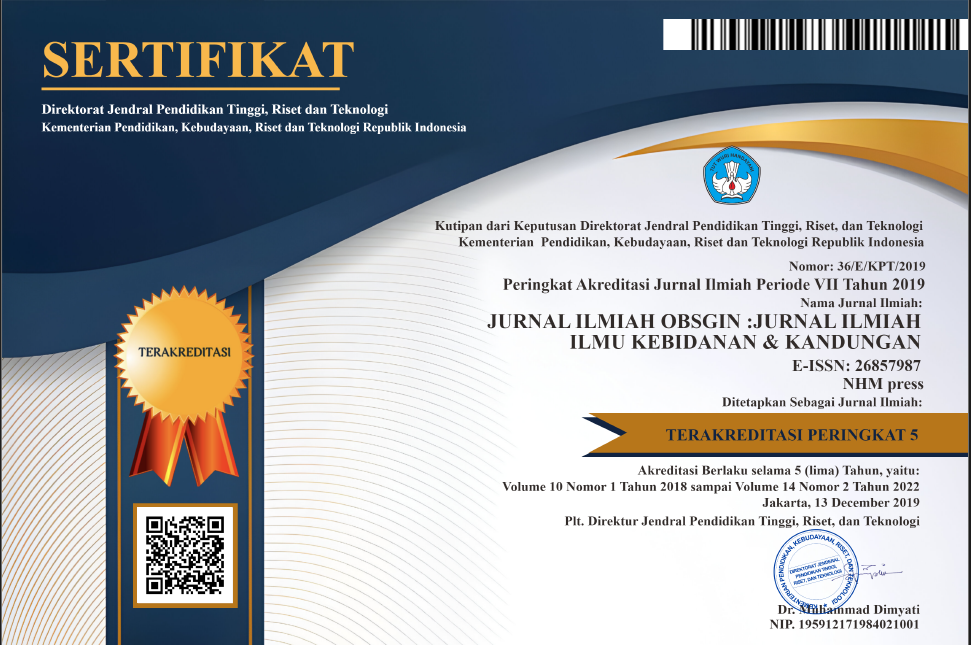The FAKTOR RESIKO ANEMIA PADA IBU HAMIL DI UPT BLUD PUSKESMAS RUMBIO KABUPATEN KAMPAR
Abstract
Anemia is the largest public health problem in the world, especially for women of reproductive age. The objective of the study was to analyze the risk factors for anemia among pregnant women in UPT BLUD Puskesmas Rumbio, Kampar. This research use analytical method with cross sectional approach. The population in this study were all pregnant women in the working area of UPT BLUD Puskesmas Rumbio periode Mei 2021, and sample of 42 people. Data analysis using univariate and bivariate analysis using distribution tables and chi square statistical test with 95% confidence interval. Statistical analysis showed a correlation between the incidence of anemia in pregnant women with gestational age (0.024), maternal interval (0.035), parity (0.016) and antenatal care (0.001).
References
2. Al-Farsi, Y. M., Brooks, D. R., Werler, M. M., Cabral, H. J., Al-Shafaee, M. A., & Wallenburg, H. C. (2012). Effect of high parity on occurrence of some fetal growth indices: A cohort study. International Journal of Women’s Health, 4(1), 289–293. https://doi.org/10.2147/ijwh.s32190
3. Anaemia, T. global prevalence of. (2011). The global prevalence of anaemia in 2011. Who, 1–48.
4. Anggi Irna Mantika, T. M. (2014). Halaman Journal of College Nutrition College. 3.
5. Badan Penelitian dan Pengembangan Kesehatan. (2018). Laporan_Nasional_RKD2018_FINAL.pdf. In Badan Penelitian dan Pengembangan Kesehatan (p. 198). http://labdata.litbang.kemkes.go.id/images/download/laporan/RKD/2018/Laporan_Nasional_RKD2018_FINAL.pdf
6. Chowdhury, H. A., Ahmed, K. R., Jebunessa, F., Akter, J., Hossain, S., & Shahjahan, M. (2015). Factors associated with maternal anaemia among pregnant women in Dhaka city. BMC Women’s Health, 15(1), 1–6. https://doi.org/10.1186/s12905-015-0234-x
7. Crawley, J. (2004). Reducing the burden of anemia in infants and young children in malaria-endemic countries of Africa: From evidence to action. American Journal of Tropical Medicine and Hygiene, 71(2 SUPPL.), 25–34. https://doi.org/10.4269/ajtmh.2004.71.25
8. Debella, A., Dheresa, M., Geda, B., Tiruye, G., & Fage, S. G. (2021). A third of pregnant women are affected by anemia in eastern ethiopia: A facility-based study. Journal of Blood Medicine, 12, 299–306. https://doi.org/10.2147/JBM.S305567
9. Gardner, W., & Kassebaum, N. (2020). Global, Regional, and National Prevalence of Anemia and Its Causes in 204 Countries and Territories, 1990–2019. Current Developments in Nutrition, 4(Supplement_2), 830–830. https://doi.org/10.1093/cdn/nzaa053_035
10. Garzon, S., Cacciato, P. M., Certelli, C., Salvaggio, C., Magliarditi, M., & Rizzo, G. (2020). Iron deficiency anemia in pregnancy: Novel approaches for an old problem. Oman Medical Journal, 35(5), 1–9. https://doi.org/10.5001/omj.2020.108
11. Liyew, A. M., Tesema, G. A., Alamneh, T. S., Worku, M. G., Teshale, A. B., Alem, A. Z., Tessema, Z. T., & Yeshaw, Y. (2021). Prevalence and determinants of anemia among pregnant women in East Africa; A multi-level analysis of recent Demographic and Health Surveys. PloS One, 16(4), e0250560. https://doi.org/10.1371/journal.pone.0250560
12. Marniyati, L., Saleh, I., Soebyakto, & B, B. (2016). Pelayanan Antenatal Berkualitas dalam Meningkatkan Deteksi Risiko Tinggi pada Ibu Hamil oleh Tenaga Kesehatan di Puskesmas Sako , Sosial , Sei Baung dan Sei Selincah di Kota Palembang Pendahuluan menjadi peserta Jaminan Kesehatan Nasional Pemerintah Propi. Jurnal Kedokteran Dan Kesehatan, 3(1), 355–362.
13. Maskey, M., Jha, N., Poudel, S., & Yadav, D. (2014). Anemia in pregnancy and its associated factors: A study from Eastern Nepal. Nepal Journal of Epidemiology, 4(4), 386–392. https://doi.org/10.3126/nje.v4i4.11358
14. McLean, E., Cogswell, M., Egli, I., Wojdyla, D., & De Benoist, B. (2009). Worldwide prevalence of anaemia, WHO Vitamin and Mineral Nutrition Information System, 1993-2005. Public Health Nutrition, 12(4), 444–454. https://doi.org/10.1017/S1368980008002401
15. Nankinga, O., & Aguta, D. (2019). Determinants of Anemia among women in Uganda: Further analysis of the Uganda demographic and health surveys. BMC Public Health, 19(1), 1–9. https://doi.org/10.1186/s12889-019-8114-1
16. Prabhakara, G. (2010). Health Statistics (Health Information System). In Short Textbook of Preventive and Social Medicine. https://doi.org/10.5005/jp/books/11257_5
17. Problem, W., & Lynch, S. R. (2011). Why Nutritional Iron Deficiency Persists as a. 19, 763–768. https://doi.org/10.3945/jn.110.130609.billion
18. Pusat Penelitian dan Pengembangan Upaya Kesehatan Masyarakat, S., & Litbangkes, B. (2016). PREVALENSI DAN FAKTOR RISIKO ANEMIA PADA WANITA USIA SUBUR DI RUMAH TANGGA MISKIN DI KABUPATEN TASIKMALAYA DAN CIAMIS, PROVINSI JAWA BARAT Prevalence and Risk Factors of Anemia among Women of Reproductive Age in Poor Household in Tasikmalaya and Ciamis Di. Jurnal Kesehatan Reproduksi, 7(2), 71–82. https://media.neliti.com/media/publications/107942-ID-prevalensi-dan-faktor-risiko-anemia-pada.pdf
19. Rahman, M. M., Abe, S. K., Rahman, M. S., Kanda, M., Narita, S., Bilano, V., Ota, E., Gilmour, S., & Shibuya, K. (2016). Maternal anemia and risk of adverse birth and health outcomes in low- and middle-income countries: Systematic review and meta-analysis. American Journal of Clinical Nutrition, 103(2), 495–504. https://doi.org/10.3945/ajcn.115.107896
20. Rahman, M. M., Abe, S. K., Rahman, M. S., Kanda, M., Narita, S., Bilano, V., Ota, E., Gilmour, S., & Shibuya, K. (2016). Maternal anemia and risk of adverse birth and health outcomes in low- and middle-income countries: Systematic review and meta-analysis. American Journal of Clinical Nutrition, 103(2), 495–504. https://doi.org/10.3945/ajcn.115.107896
21. Republic, F. D. (2015). National Nutrition Programme Republic of Ethiopia. June 2013.
22. Riau, D. K. P. (n.d.). Profil Kesehatan Riau Tahun 2019 (Issue 0761).
23. SCOTT, J. M. (1959). Iron deficiency anaemia in pregnancy. Medical World, 91, 308–311.
24. Stevens, G. A., Finucane, M. M., Maria De-Regil, L., Paciorek, C. J., Flaxman, S. R., Branca, F., Pablo Peña-Rosas, J., qar Bhutta, Z. A., & Ezzati, M. (2013). Global, regional, and national trends in haemoglobin concentration and prevalence of total and severe anaemia in children and pregnant and non-pregnant women for 1995–2011: a systematic analysis of population-representative data. The Lancet Global Health, 1, e16–e25. https://doi.org/10.1016/S2214-109X(13)70001-9
25. World Health Organization, Stoltzfus, R. J., & Dreyfuss, M. L. (2013). Prevention of Iron Deficiency Anaemia in Adolescents Role of Weekly Iron Acid Supplementation. In Pediatrics (Vol. 138, Issue 1). https://doi.org/10.3390/nu6125915
26. World Health Organization, Williams, a L., van Drongelen, W., Lasky, R. E., Sanderson, M., Lai, D., Selwyn, B. J., Wang, Y., Zhang, W., Li, X. Q., Yu, L. M., & Wang, D. H. (2012). Guideline : Daily iron and folic acid supplementation in pregnant women. World Health Organization, 46, 323–329.











